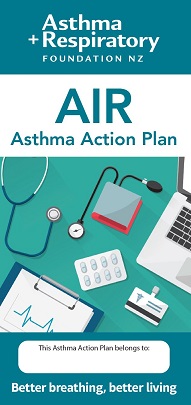Wishing everyone happy holidays and a joyful New Year from the Healthify team. Don't forget to Slip, Slop, Slap and Wrap!
AIR (anti-inflammatory reliever) asthma therapy
Key points about AIR asthma therapy
- AIR asthma therapy refers to the use of an anti-inflammatory reliever (AIR) inhaler to manage your asthma.
- The anti-inflammatory reliever inhalers are Symbicort® or DuoResp Spiromax®.
- They can be used for the relief of mild asthma symptoms or on an ongoing basis for the prevention AND relief of asthma symptoms.
- Read about AIR asthma therapy and AIR asthma action plans.

AIR asthma therapy refers to the use of an anti-inflammatory reliever (AIR) inhaler to manage your asthma. Your AIR inhaler can be used for quick relief of asthma symptoms AND as a preventer used every day for ongoing control of your asthma.
The anti-inflammatory reliever inhalers used for AIR therapy are Symbicort® or DuoResp Spiromax®.
Symbicort or DuoResp Spiromax are dry powder inhalers. Each inhaler has a combination of 2 medicines, budesonide and formoterol, in a single inhaler.
- Budesonide is a corticosteroid that works by reducing inflammation in your airways. It works within hours and the effect lasts several hours.
- Formoterol works to open your airways quickly (within minutes) and the effect will last at least 12 hours after the dose.
The most commonly used strength for AIR therapy is budesonide 200 microgram + formoterol 6 microgram.
Note: Symbicort and DuoResp Spiromax are different devices.
- Symbicort is a turbuhaler and DuoResp Spiromax is a breath activated inhaler.
- The choice of brand depends on which inhaler you find easiest to use.
- Your healthcare provider will show you how to use your inhaler. Good technique gives good asthma control.
- Read more about inhalers.
Follow your AIR asthma action plan to help manage your symptoms. This a written plan to help you manage your asthma each day. It also tells you how to recognise and cope with worsening symptoms. Make sure you always carry your reliever with you. Remember to regularly check your inhaler technique with your healthcare provider.
If you have mild asthma
If you have mild symptoms, you only need to use your Symbicort or DuoResp Spiromax inhaler occasionally, when you get asthma symptoms, eg, shortness of breath, wheezing, chest tightness and cough.
Mild asthma is when:
- you only get asthma symptoms occasionally (less than twice a month)
- you only need help managing your asthma at certain times of the year, eg, during pollen season
- you only need help for symptoms triggered occasionally, eg, by other people’s pets
- you only need help managing your symptoms when you exercise.
If you have moderate to severe asthma
Use your Symbicort or DuoResp Spiromax for the prevention AND relief of asthma symptoms.
- If your asthma symptoms occur more frequently your healthcare provider will recommend that you use your inhaler (1 or 2 puffs) EVERY DAY, either once or twice daily, as a preventer. Your dose will depend on how bad your symptoms are.
- Also, if your asthma symptoms get worse or you have an asthma attack, you can use extra doses of your inhaler – up to a maximum of 12 puffs daily if needed. This quickly reduces inflammation of the airways and helps you to breathe more easily. For more information, see asthma first aid below.
- Note: The use of your anti-inflammatory reliever for the prevention AND relief of asthma symptoms is also called ‘Single inhaler Maintenance and Reliever Therapy’ (SMART).
Your asthma is getting severe when:
- your asthma symptoms are getting worse (wheeze, tight chest, a cough or feeling breathless), or
- your inhaler is only helping for 2 to 3 hours, or
- you're using more than 8 puffs a day in total (regular + reliever use), or
- you feel you need to see your healthcare provider.
How do I know when my asthma is under control?
Your asthma is under control when:
- you don’t have asthma symptoms most days (wheeze, tight chest, a cough or feeling breathless)
- you have no cough or wheeze at night
- you can do all your usual activities and exercise freely
- most days you do not need extra budesonide/ formoterol inhalations.
The following are AIR asthma action plans. It’s a written plan to help you manage your asthma each day. It also tells you how to recognise and cope with worsening symptoms. Fill this in with your doctor, nurse or other healthcare provider.

Choose the action plan applicable to you, depending on the inhaler you are using (Symbicort, DuoResp Spiromax or an MDI such as Ventolin® or SalAir®). The action plans come from the Asthma and Respiratory Foundation of New Zealand.
AIR Asthma Action Plan for Turbuhaler
When you have asthma, inflammation in your airways can cause asthma symptoms and asthma attacks. Your airways get narrow and inflamed when you come across your asthma triggers, making it harder to breathe.
- Reliever inhalers usually have a bronchodilator, which works to open your airways.
- Preventer inhalers (also called maintenance inhalers) are usually corticosteroids which reduce swelling and inflammation of the airways.
The main benefit of AIR therapy is that you use 1 inhaler for both the relief of asthma symptoms when needed, and for prevention of asthma when it's used every day.
✔ Using a combination inhaler provides fast relief of asthma symptoms and opens up your airways quickly when you have asthma symptoms.
✔ It also contains a corticosteroid so it can reduce inflammation which caused your symptoms.
✔ This lowers your risk of having more symptoms or an asthma attack in the future.
✔ For moderate to severe asthma, using your combination AIR inhaler everyday prevents asthma and keeps your asthma under control.
✔ If your asthma symptoms get worse, or you have an asthma attack, you can use extra doses of your inhaler – up to a maximum of 12 puffs per day, if needed. This quickly reduces inflammation of your airways and helps you to breathe more easily.
✔ Using AIR therapy is better for improving breathing and controlling symptoms in the long term and for reducing the risk of asthma attacks.
You can also use your AIR inhalers (Symbicort or DuoResp Spiromax) during an asthma attack. It's important to carry your reliever inhaler with you at all times, because anyone with asthma can have a severe asthma attack. An asthma attack may be mild, moderate or severe and can take anything from a few minutes to a few days to develop. Symptoms may be mild or moderate and can quickly get worse so it's important to act fast.
Symbicort or DuoResp Spiromax
- Use 1 puff initially and repeat if needed, up to 12 puffs daily. These inhalers quickly reduce inflammation of your airways and help you to breathe more easily.
- If you have an asthma action plan follow the instructions on there.
Severe symptoms – call 111 if:
- you're gasping for breath
- you can't speak a full sentence in 1 breath
- you're blue around the mouth
- your peak flow reading's getting worse (if checked)
- you've used a reliever inhaler but it's not helping much.
Continue to use your inhaler every few minutes until the ambulance arrives. Read more about asthma first aid.
Brochures
AIR Asthma Action Plan for Turbuhaler, Asthma and Respiratory Foundation, NZ, 2025
- English(external link)
- Te reo Māori(external link)
- Samoan(external link)
- Tongan(external link)
- Simplified Chinese(external link)
AIR Asthma Action Plan for Spiromax(external link), Asthma and Respiratory Foundation, NZ, 2025
AIR Asthma Action Plan for MDI with spacer(external link), Asthma and Respiratory Foundation, NZ, 2025
References
- NZ adolescent and adult asthma guidelines 2020(external link) Asthma + Respiratory Foundation, NZ
- Asthma – thinking SMART, using AIR and making a difference(external link) He Ako Hiringa, NZ, 2022
Brochures

AIR Asthma Action Plan for Turbuhaler
Asthma and Respiratory Foundation, NZ, 2025

AIR Asthma Action Plan for Spiromax
Asthma and Respiratory Foundation, NZ, 2025

AIR Asthma Action Plan for MDI with spacer
Asthma and Respiratory Foundation, NZ, 2025
Credits: Sandra Ponen, Pharmacist, Healthify He Puna Waiora. Healthify is brought to you by Health Navigator Charitable Trust.
Reviewed by: Angela Lambie, Pharmacist, Auckland
Last reviewed:





